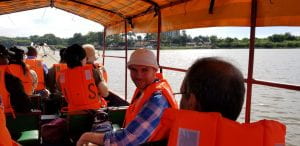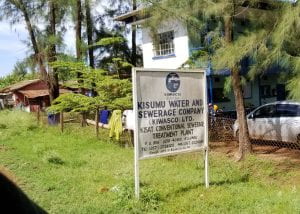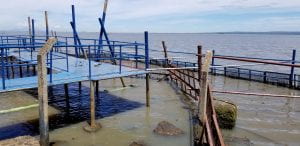On Day 2 (April 28) of our Lake Victoria Basin field trip in Kisumu, we went down to Hippo Point to view the local invasion of water hyacinth, a noxious invasive plant that clogs waterways worldwide. It loves nutrient-rich waters. Cargele noted that earlier this spring, water hyacinth filled the entire bay between Hippo Point and downtown Kisumu, seen in the distance in the photo below.

The guide for the boat in the foreground was so knowledgeable, that he convinced our group to take an unplanned excursion to see the local hippos.
Safety first! We all got our life jackets and had just enough seats for everyone in the group.
Yes – hippos! The guide noted that this group of hippos is particularly acculturated, and therefore not very aggressive. Evidently, if we’d gotten this close to hippos “in the wild”, they would have charged our boat. Later, on safari in Masai Mara, the guide there noted that wild hippos are one of the most dangerous animals in Africa (along with lions, Cape buffalo, and elephants). Everyone agreed this unplanned excursion was a highlight of our trip.

 So, what happened to all the water hyacinth that had clogged Kisumu Bay? Evidently, changes in winds started blowing it across the Winam Gulf (the arm of Lake Victoria on which Kisumu sits) toward Homa Bay – where we’d driven the day before on our way to Mbita and ICIPE. Here, you can see rafts of water hyacinth adrift on the lake.
So, what happened to all the water hyacinth that had clogged Kisumu Bay? Evidently, changes in winds started blowing it across the Winam Gulf (the arm of Lake Victoria on which Kisumu sits) toward Homa Bay – where we’d driven the day before on our way to Mbita and ICIPE. Here, you can see rafts of water hyacinth adrift on the lake.Next stop on our tour of the anthropogenic water cycle in Kisumu was the Kisumu Sewage Treatment Plant – a rare gem that most tourists to the area never get to see. Caroline Omolo, Safety, Health, Environment and Quality Manager of water treatment for Kisumu, led us through the facilities.
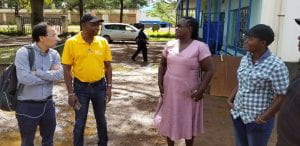




The sewage treatment plant is reasonably successful – effluent has only ~1-3 mg N/L, though they have more difficulty with phosphorus (20-30 mg P/L). Unfortunately, it’s not the treatment plant technology that leads to water quality difficulties. Elizabeth explained that only ~8% of Kisumu residents are hooked up to sewarage, and when treatment plant effluent is released into the adjacent river, it actually makes the river water cleaner. That’s because of large unplanned settlements just upstream that have no water or sewage infrastructure at all. Wastewater just goes directly into the river, and thence into Lake Victoria. Bottom line is that, at least in part, resolving nutrient (and other) pollution in Lake Victoria isn’t primarily a scientific or technological problem, so much as a social, economic, and infrastructure problem: how to get all those people hooked up to clean water and sewage treatment?

Next stop was the water intake for the Kisumu drinking water treatment plant (the green pipes in the photo on the left). Note the extensive screening, in part to keep out all the water hyacinth (photo on right).


After the settling ponds, much of the turbidity is gone and subsequent chlorination makes the water potable. This all looked great to me, but begged the question: why do all the guidebooks emphasize “Don’t drink the tap water anywhere (even the fancy hotels) in Kenya!”? Evidently, the answer is again infrastructure: leaky distribution pipes due to age, construction damage, etc. mean that what leaves the water treatment plant can get contaminated on the way to the tap.
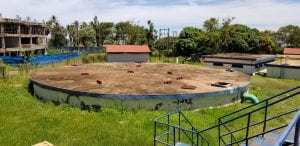

As we flew out of Kisumu back to Nairobi, we got a final glimpse of large mats of water hyacinth drifting across the Winam Gulf toward Homa Bay.

